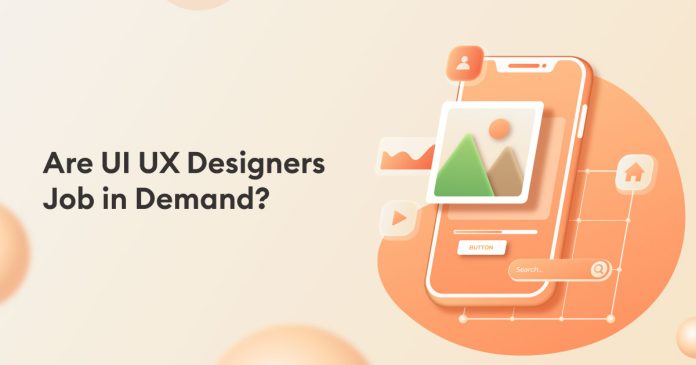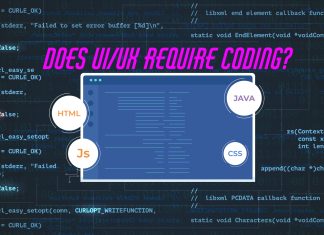Before choosing a career path, we often consider the demand and future prospects of that field. This is true for folks who want to be UI/UX designers. They might wonder: Are UI UX designer jobs in demand? Especially since it’s relatively new compared to programming or graphic design. In this blog, we’ll explain into the details of UI/UX design careers, job demand, and what the future holds for this industry. Let’s jump into the topic and explore it further.
Demand for UI/UX Designers
As the world relies more on technology, user-friendly and aesthetically pleasing interfaces become crucial. This translates to a demand for UI/UX designers to create seamless and interactive digital experiences. According to the US Bureau of Labor Statistics, the job market for UI/UX designers is expected to grow by 23% from 2021 to 2031—much faster than many other professions.
A UI/UX designer focuses on making websites, apps, software applications, or physical products easy and enjoyable to use, leading to increased user engagement and satisfaction. Without a focus on user experience (UX), your digital or physical product might be confusing or difficult to navigate. Complicated products turn users away. This increases the demand for UI/UX designers, and also answers our question: Are UI/UX designer jobs in demand?
Growth of Digital Products
The rise of e-commerce and online businesses has fueled the demand for skilled UI/UX designers. These designers are essential for creating positive experiences that keep customers coming back. A well-designed UI/UX can make all the difference, ensuring customers effortlessly find what they need and complete purchases in the competitive online landscape.
In this digital age, customers are more likely to return to websites or products where they’ve had good experiences. This fosters business growth by attracting both new and repeat customers. UI/UX designers do more than just make things look good. They understand user behavior and design interfaces that are not only visually appealing but also efficient and user-friendly.
The world of e-commerce is ever-evolving, with new technologies and design trends emerging constantly. UI/UX designers must ensure that digital products look perfect across various devices—desktops, tablets, and mobile phones—requiring a deep understanding of user interactions. The continuous growth of digital products signals ongoing demand for UI/UX designers.
Impact of Mobile and Web Development
The growth of mobile and web development has underscored the importance of UI/UX design. With countless apps and websites vying for attention, users expect a seamless and intuitive experience. UI/UX designers are pivotal in ensuring interfaces are easy to navigate across various screen sizes and devices.
For example, if you scroll through app reviews on the Play Store or App Store, you’ll often find users criticizing apps solely based on their user experience. Similarly, cluttered homepages and confusing navigation on websites frustrate users, making it hard to find what they’re looking for.
Businesses now prioritize user-centered design, where UI/UX designers conduct user research, create prototypes, and test different solutions to enhance user experience. The growth of mobile and web development has created numerous opportunities for UI/UX designers to excel.
Every business needs a website because an online presence helps a business to grow more. Consider how many businesses you know that don’t have a website. Every day, thousands of new websites and apps launch, further highlighting the demand for UI/UX designers.
Is UI or UX in Higher Demand
Although we often say UI/UX or UX/UI together, they actually focus on different aspects. UI and UX are distinct areas, each addressing various aspects of a user’s interaction with a product.
UI (User Interface) design concerns itself with the product’s appearance. UI designers create the visual elements users interact with, such as buttons, icons, menus, color palettes, and more.
On the other hand, UX (User Experience) design takes a broader view. UX designers consider the entire user journey when interacting with a product or service. This involves conducting research to understand user goals and ensuring the product is accessible to all users, regardless of their abilities.
In terms of demand, UX designers often have more job opportunities compared to UI designers. This is because UX skills encompass a wider range of the design process, allowing UX designers to apply for both UI and UX roles. However, learning UI is relatively easier and quicker compared to UX, as it focuses mainly on the visual elements of the product. That’s why it’s easy to get your first job as a UI designer and gradually learn UX skills in your spare time, with the ultimate goal of becoming a UX designer.
Remote UI/UX Designer Jobs
The demand for remote UI/UX designers is growing rapidly. Many companies are adopting remote work setups, leading to a rise in remote design opportunities. This trend enables companies to access top talent worldwide, broadening their pool of options. Thanks to digital tools like Slack, Asana, Zeplin, Zoom, Figma, and many more designers can seamlessly collaborate with teams regardless of location. For instance, Figma’s real-time collaboration feature is a game-changer for design teams.
The work of UI/UX designers involves tasks like user research, creating mockups, and refining designs—all of which can be easily done online. Since the entire process is digital, designers only need a computer and an internet connection to work from anywhere, be it home or elsewhere.
Freelance UI/UX Designer opportunities
Many UI/UX designers are seizing Freelance UI/UX Designer opportunities on platforms like Fiverr and Upwork. As the number of clients hiring UI/UX designers increases, especially among startups and small businesses, freelancers are in high demand for their cost-effective expertise. Freelancers enjoy the flexibility of setting their own hours and workload, allowing for a personalized work-life balance. In fact, many experienced freelancers earn more than those in traditional design positions.
However, freelancing comes with its challenges. There’s no guaranteed paycheck, so maintaining a steady income requires consistent client acquisition. Positive reviews can boost visibility on platforms, but freelancers must handle contract negotiations, project management, and payment chasing independently. Unlike traditional jobs, freelancers miss out on benefits like health insurance or paid time off.
Despite the challenges, freelancing offers valuable experience. It exposes designers to real client projects, enhancing skills in communication, problem-solving, and understanding client needs. It’s a great way to kickstart a UI/UX career and gain practical skills beyond design.
Future of UI/UX Design Careers
The future of UI/UX design careers looks promising! As the field becomes more specialized, companies will soon seek designers with specific expertise in areas like UX research, content design, or voice user interfaces. This creates more job opportunities for UI/UX designers.
Moreover, UI/UX design is always changing. If you compare Android OS interfaces and functionality from five years ago to the latest ones, you’ll notice significant improvements in user experience. People are drawn to new trends because it enhances their overall experience, which means more opportunities for UI/UX designers. To learn the latest UI trends, click here.
To succeed, it’s essential to stay updated on trends and hone your skills in user research. Creating products that truly cater to users is crucial. Additionally, AI is shaping the future and can streamline repetitive tasks, giving designers more time to focus on creative user research.
Our Thoughts on Are UI UX Designer Jobs in Demand?
We believe that the demand for UI/UX designers is growing, and it will continue to rise as technology advances. We constantly witness innovation in our products, with new inventions such as AR/VR technology, foldable phones, rollable TVs, self-driving cars, smart glasses, and more emerging. Figuring out how these functionalities will operate is the responsibility of UI/UX designers.



